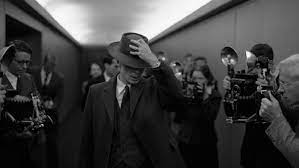⭐⭐⭐⭐
Barbie and Oppenheimer, the two biggest showstopping films of summer ’23. The debate over which to view hit the internet, but I knew I had to see the rise of the world’s most deadly weapon.
My friend Anna Webb and I had planned our trip to the theater on a scorching summer day. We prepaid our tickets for the show as the line was through the door. By the time we were able to get our tickets checked, the movie had already begun. Opening the door to screening six, we first heard the timely language of a historical thriller.
Based on a true story during World War II, J. Robert Oppenheimer’s historical aspect shines through, telling the story of J. Robert Oppenheimer, a theoretical physicist, portrayed by Cillian Murphy (Inception, Peaky Blinders). He managed the Manhattan project with the help of Albert Einstein. Known as the father of the atomic bomb, Oppenheimer was accused of having relations with the communist party by the chairman of the Atomic Energy Commission, Lewis Strauss, played by Robert Downey Jr. (Avengers, Sherlock Holmes). Quickly the two became mortal enemies.
Executed initially as a drama/thriller, Oppenheimer morphed into a more factually-based film, directed by Christopher Nolan, known for his work in Inception and Interstellar. Nolan conducted the characters in a way that gave them complex identities in balancing their morals and occupations. Based on his calculations, Oppenheimer feared that the creation of the nuclear weapon had the power to detonate entire cities. Being sworn to secrecy during the bomb’s production, Oppenheimer ruined relationships.
Nolan depicted black and white scenes to match the intensity of Strauss’s perspective against Oppenheimer, creating a separate plot. The sound quality of silence throughout the movie was used to signify the bomb’s existence, symbolizing its power against humanity. The emotions varied during the trajectory of the war, creating more tension and need for competition. Oppeheimer’s passion and success in his field quickly became dangerous as he realized his scientific capabilities in crafting atomic weapons. The director intends for the audience to feel and understand the reality of the Manhattan project, as well as the panic Americans experienced throughout the war. Fear is prominent as the physicist feels responsible for what he has done, fearfully stating, “Now I am becoming Death. the destroyer of worlds,” a groundbreaking statement.
Without a doubt there is controversy in the way Oppenheimer was portrayed to audiences, as it focused more on the power that Oppenheimer was praised for. For a three hour long movie it was both informative and entertaining, but unnecessarily lengthy. Timelessly, Oppenheimer influences integrity, highlighting a man’s morals. The factual evidence thrown at the audience completely defeats the advertisement of a thriller. If anything, Oppenheimer is a historical masterpiece.






